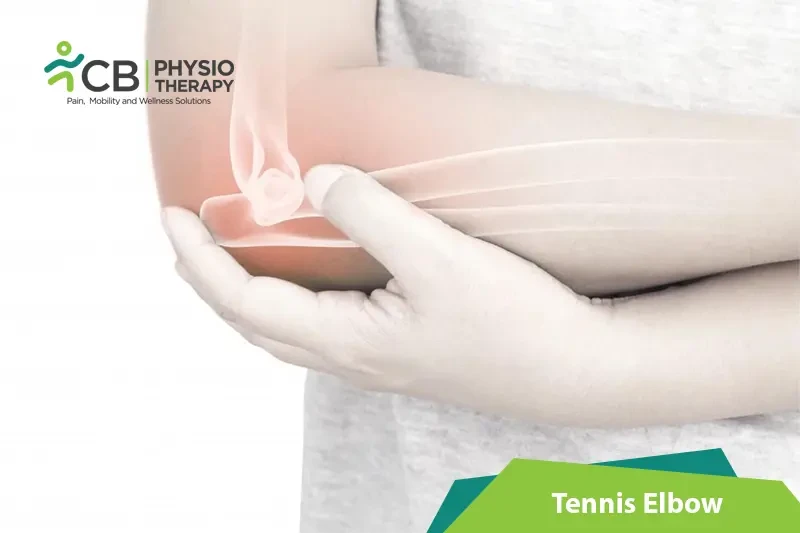
Tennis elbow or lateral epicondylitis is a condition in which the outer part of the elbow becomes sore and tender. It is commonly caused by non inflammatory, chronic degenerative changes (Enthesopathy) in the tendon that attach forearm muscle extensor carpi radialis brevis (ECRB) to elbow. It is most prevalent in middle age and in men more than women. The disease is idiopathic, benign, and self-limiting.
· Pain in the outer part of elbow (lateral epicondyle).
· Point tenderness over the lateral epicondyle – a prominent part if bone on the outside of elbow.
· Pain from gripping and the movements of the wrist, especially wrist extension and lifting movements.
· Pain from activities that use the muscles that extend the wrist (e.g. pouring a container of liquid, lifting with the palm down, sweeping, especially where wrist movement bus required.
· Morning stiffness.
· Symptoms associated with tennis elbow include radiating pain from the outside of the elbow to the forearm and wrist, weakness of forearm, painful grip while shaking hands and not being able to hold relatively heavy items in the hand.
Tennis elbow is often an overuse injury primarily from repetitive strain from tasks and activities that involve loaded and repeated gripping and/or wrist extension. It historically occurs in tennis players but can result from any sports that requires repetitive extension of wrist, radial deviation, and/or forearm supination.
James Cyriax, 'father of orthopedic medicine', proposes one explanation of how tennis elbow may come about. The hypothesis states that there are microscopic and macroscopic tears between the common extensor tendon and the periosteum of the lateral humeral epicondyle. An operation conducted in this study showed that 28 out of 39 patients showed tearing at the tendon cuff.
To diagnose tennis elbow, the physician performs a battery of tests in which he places pressure on affected area while asking the patient to move the elbow, wrist and fingers.
X-rays can confirm and distinguish possibilities of existing causes of pain that are unrelated to tennis elbow, such as fracture or arthritis.
MRI screening can confirm excess fluid and swelling in the affected region in the elbow, such as the connecting point between the forearm bone and the extensor carpi radialis brevis.
Diagnosis is made by clinical signs and symptoms that are discrete and characteristic. With the elbow fully extended, the patient feels points of tenderness over the affected point on the elbow. There is also pain with passive wrist flexion and resistive wrist extension (Cozen’s test).
The management approach of tennis elbow is known as Lateral Epicondyle Tendinopathy, is adapted from general principles of Tendinopathy rehabilitation. For the benefit of achieving long term goals and to meet individuals need, rehabilitation should be a multi-modal perspective. This includes education, exercise, tissue loading management, manual therapy, steroid injection and taping.
· Patient education: Educating patients on their condition, prognosis, management options and self-management may be effective with long term if used in combination with other measures for the management of Tennis elbow.
Smoking, high consumption of processed and fatty food and obesity can delay recovery.
· Exercises: Exercise for Tendinopathy rehabilitation is eccentric contraction. They are considered to be an effective measure for tendon overuse injuries.
Gradual progression of exercise is essential to increase tendon tolerance to loads. The following are the different ways to progress your exercise;
Elbow and forearm position: begin with flexed elbow and forearm in supination, then progress by increase elbow extension angle.
Fingers flexion vs extension: Beginning with fingers in flexion, then progressing to extension to load the long extensors.
. Adding weights: whether by an exercise band or dumbbells.
. Weight bearing exercises.
· Load management: Reduction of load on the tendon is an effective management strategy which has to go hand in hand with building tissue resilience to allow for gradual progression to target load by training the mechanical properties of the tendon. A good way of altering the load is to ask patients to work under the pain threshold and engage them in exercises that load the tendon below the level of exaggerated pain.
· Manual therapy: Mobilization with movement can be utilized with other measures to reduce pain and facilitate exercise. Mulligan’s mobilization with movement in TE has proved to be effective.
· Steroid injection: Corticosteroid injection has good outcome for short term use only (only 6 weeks). It’s long term use resulted in high recurrence. However, the short-term benefit of pain relief can be sought to encourage patient’s engagement with exercise program.
· Taping: Taping has a good placebo pain relief effect and pain-free grip strength in patients with chronic tennis elbow. Studies support that a combination of kinesio tape and exercise is very effective.
Select your City to find & connect with our experts regarding Physiotherapy for Tennis Elbow